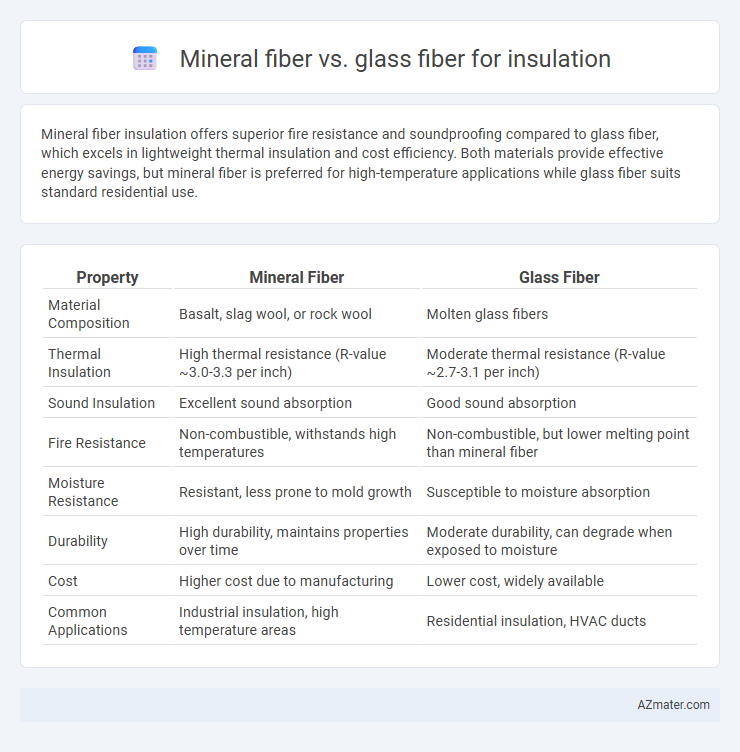Mineral fiber insulation offers superior fire resistance and soundproofing compared to glass fiber, which excels in lightweight thermal insulation and cost efficiency. Both materials provide effective energy savings, but mineral fiber is preferred for high-temperature applications while glass fiber suits standard residential use.
Table of Comparison
| Property | Mineral Fiber | Glass Fiber |
|---|---|---|
| Material Composition | Basalt, slag wool, or rock wool | Molten glass fibers |
| Thermal Insulation | High thermal resistance (R-value ~3.0-3.3 per inch) | Moderate thermal resistance (R-value ~2.7-3.1 per inch) |
| Sound Insulation | Excellent sound absorption | Good sound absorption |
| Fire Resistance | Non-combustible, withstands high temperatures | Non-combustible, but lower melting point than mineral fiber |
| Moisture Resistance | Resistant, less prone to mold growth | Susceptible to moisture absorption |
| Durability | High durability, maintains properties over time | Moderate durability, can degrade when exposed to moisture |
| Cost | Higher cost due to manufacturing | Lower cost, widely available |
| Common Applications | Industrial insulation, high temperature areas | Residential insulation, HVAC ducts |
Introduction to Insulation Materials
Mineral fiber and glass fiber are both widely used insulation materials due to their excellent thermal and acoustic properties. Mineral fiber, often derived from volcanic rock or slag, offers superior fire resistance and sound absorption compared to glass fiber, which is made from fine strands of molten glass. Both materials provide effective insulation solutions, but mineral fiber typically has higher density and durability, making it suitable for industrial and high-temperature applications.
What is Mineral Fiber Insulation?
Mineral fiber insulation, also known as rock wool or stone wool, is made from natural or synthetic minerals such as basalt or diabase, melted and spun into fibrous materials suitable for thermal and acoustic insulation. It offers high fire resistance, excellent sound absorption, and moisture resistance, making it ideal for industrial and residential applications. Compared to glass fiber insulation, mineral fiber typically provides superior thermal performance and durability under high-temperature conditions.
What is Glass Fiber Insulation?
Glass fiber insulation consists of fine strands of glass woven into a material used to reduce heat transfer and improve energy efficiency in buildings. It offers high thermal resistance (R-value), is non-combustible, and provides soundproofing benefits. Compared to mineral fiber, glass fiber insulation is lighter, typically less expensive, and resists moisture, making it a popular choice for residential and commercial applications.
Manufacturing Processes Compared
Mineral fiber insulation is produced by melting natural or synthetic minerals such as basalt and slag at temperatures above 1400degC, then spinning them into fibers, resulting in a dense and fire-resistant material. Glass fiber insulation is created by melting silica sand and recycled glass at around 1500degC, followed by rapid cooling and fiberizing, which produces lightweight, flexible fibers with excellent thermal resistance. Differences in raw materials and melting temperatures lead to variations in density, thermal conductivity, and fire performance between mineral fiber and glass fiber insulation products.
Thermal Performance and Efficiency
Mineral fiber insulation typically offers superior thermal performance compared to glass fiber, due to its higher density and ability to trap air more effectively, which reduces heat transfer. Glass fiber insulation provides good thermal efficiency at a lower cost and with easier installation, but it may lose insulating properties if compressed or improperly installed. Both materials have distinct thermal resistance values (R-values), with mineral fiber generally delivering a more stable and durable thermal barrier in extreme temperature conditions.
Fire Resistance Capabilities
Mineral fiber insulation offers superior fire resistance due to its non-combustible composition, with melting points typically above 1,200degC, making it ideal for high-temperature applications and providing robust fire containment. Glass fiber insulation also provides good fire resistance, with melting points around 850degC, but it is less effective than mineral fiber in extreme heat scenarios and prolonged fire exposure. Choosing mineral fiber over glass fiber significantly enhances fire safety in buildings requiring stringent fire-resistance ratings and compliance with fire codes.
Acoustic Insulation Properties
Mineral fiber insulation offers superior acoustic performance due to its denser and more fibrous structure, effectively absorbing a broad range of sound frequencies and reducing airborne noise transmission. Glass fiber insulation also provides good sound absorption but typically performs better in higher-frequency ranges, making it less effective for low-frequency noise reduction compared to mineral fibers. Both materials are widely used in HVAC and building applications, but mineral fiber is often preferred where enhanced soundproofing is critical.
Environmental Impact and Sustainability
Mineral fiber insulation, often produced from natural basalt or slag waste, offers enhanced sustainability by utilizing recycled materials and exhibiting lower embodied energy compared to glass fiber insulation, which primarily relies on energy-intensive glass melting processes. Both materials provide effective thermal performance, but mineral fiber's higher durability and resistance to moisture extend the lifespan of insulation systems, reducing waste and replacement frequency. The environmental impact of mineral fiber insulation is further minimized due to its recyclability and lower carbon footprint, making it a more eco-friendly choice for sustainable building applications.
Cost and Installation Considerations
Mineral fiber insulation typically costs more than glass fiber due to its denser composition and enhanced fire resistance. Installation of mineral fiber requires greater care because of its heavier weight and potential for skin irritation, whereas glass fiber is lighter and easier to handle with standard protective equipment. Considering budget constraints and labor intensity, glass fiber usually offers a more cost-effective and straightforward installation process for residential and commercial insulation projects.
Choosing the Right Insulation: Mineral Fiber vs Glass Fiber
Mineral fiber insulation offers superior fire resistance, soundproofing, and moisture resistance compared to glass fiber, making it ideal for industrial and high-temperature applications. Glass fiber insulation excels in affordability, ease of installation, and thermal performance, often preferred for residential and commercial buildings. Choosing between mineral fiber and glass fiber depends on factors such as fire safety requirements, acoustic needs, moisture exposure, and budget constraints.

Infographic: Mineral fiber vs Glass fiber for Insulation
 azmater.com
azmater.com